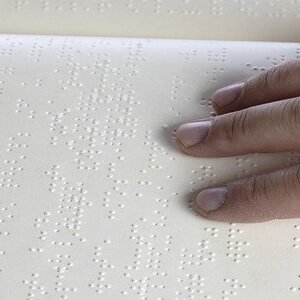Most of us believe that braille is a mere reading and writing tool for the blind or visually impaired; however, braille has many more uses in day-to-day life of the visually impaired.
[the_ad id=”6076″]
Some people also believe that braille can be or will be replaced by digital tools, audio-based navigation and AI-based narrators. Although, these new hi-tech tools are going to gain increasing popularity among the differently abled in times to come, the importance of braille remains unchanged.
We all know for a fact that the kids in the NextGen will hardly write; they will type more and use audio-visual, digital devices for learning; but that will not change the need to be able to read and write. Braille makes a visually impaired individual literate and that is something no digital tool can replace.
Today is World Braille Day and here are some other fun facts about braille that you may want to know:
- Braille had its origin in a system adapted by French army for ‘night writing.’
- Well, we all know that Braille is not a language; however, it is not even a single script! Braille codes exist for several languages around the globe. Several countries have their own Braille script, just the way they have unique languages and scripts. In India, we have ‘Bharatiya Braille’ exclusively used in India.
- Some people actually still believe that 1 dot stands for A in braille, 2 dots for B, 3 dots for C and so on. It would mean that to write Z you would need 26 dots. No! It does not work that way. Braille is a 6-dot code which helps people to read and write by touch. Braille is a combination of different dots used to create different dot patterns. It is not the number of dots but the positioning of the dots that determines what letter it is. 63 combinations are possible in the six-dot system.
- Not more than 1% of the world’s literature has been converted into braille; however, there is enough literature in braille to keep an individual well informed about the world.
- Many classic games such as Monopoly and Lego are available in their braille form.
- A major drawback of braille is that it takes up much more space than print. A standard novel may become 10 times its volume if translated in braille. There’s a shortened version of braille called Grade II which takes up much lesser space.
- There is a form of braille used exclusively for mathematics- it is called Nemeth Code!
- An average-sighted person reads around 300 words per minute, some fast braille readers can go through a book at the speed of 400 words a minute, using both the hands.
- Braille is used by visually impaired people to read and write, not just for studying but also for labelling, writing to do lists, legal work, recreational reading, and what’s more even advertisement..
Braille in healthcare: Visually impaired people use braille to independently take charge of their health:
The embossed letters on the pill packs help them understand the names of medicine. The European countries have a mandate on pill packs to have braille names on them.
Using braille, many put their pills in Ziplock bags labelled with time of the day they are supposed to take that medicine.
Some ‘homes for the visually impaired’ have the menu put out in braille-embossed form, so they can know the menu without seeing it.
Some developed countries send out lab test results to the visually impaired in braille.
Braille is not difficult to learn. Remember those childhood days when you were introduced to some swiggly letters on paper and were instructed to start making sense from them? Braille is nothing but making tactile sense of a system of dots. It gets better with practice!
We are sure that the next time you see the braille numbers on elevators or ATM, or those embossed names on the pack of medicines, you will appreciate Louis Braille all the more!
Source:

Dr. Mamta Lele- Pawara
(MD Ayurveda-Internal Medicine, CRAV-Kayachikitsa, MA Sanskrit)
